Address any questions or comments regarding this newsletter to the individual authors listed after each article or to its editors, Nathan Johanning, 618-939-3434, njohann@illinois.edu or Bronwyn Aly 618-695-6060, baly@illinois.edu. The Illinois Fruit and Vegetable News is available on the web at: http://ipm.illinois.edu/ifvn/. To receive or be removed from email notification of new postings of this newsletter, contact Nathan Johanning or Bronwyn Aly at the phone numbers or email addresses above.
In This Issue:
Upcoming Programs (listings for beginning and established growers)
News & Announcements (Creating Safe Farmer’s Markets in 2020 Webinar, COVID-19 Effects on Illinois Pesticide Applicator Training, Testing, and Licensing, FSMA Inflation Adjusted Cut Offs)
Regional Reports (east central Illinois, central Illinois, west central Illinois (Macomb & Quincy), St. Louis metro east, southwestern Illinois, southern Illinois, Dixon Springs)
Fruit & Vegetable Production & Pest Management (Modified Growing Degree Days for Insect Development (Base 50⁰ F, January 1 - April 14), Asparagus Beetle Management)
Upcoming Programs
See the University of Illinois Extension Local Food Systems and Small Farms Team’s website at:
http://web.extension.illinois.edu/smallfarm/ and the calendar of events at http://web.extension.illinois.edu/units/calendar.cfm?UnitID=629.
- Creating Safe Farmer’s Markets in 2020 Webinar. Wednesday, April 22 and Friday April 24, 2020, Noon to 1 p.m. To register visit https://web.extension.illinois.edu/registration/?RegistrationID=22188. Contact Laurie George at ljgeorge@illinois.edu for more information or see the article below in News & Announcements.
- Summer Horticulture Field Day. Thursday, June 11, 2020. Edwards Apple Orchard West 8218 Cemetery Rd, Winnebago, IL 61088. Educational program and Farm Tours as a part of the annual summer field day organized by the Illinois State Horticulture Society. For tickets visit www.tickettailor.com/events/ishs. For further information about the program contact Jenna Spychal jenna@jonamacorchard.com or 815-825-2158.
- Pumpkin Field Day. Thursday September 3, 2020 10:00 a.m. SIU Belleville Research Center, 2036 Charles Ln. Belleville, IL 62221. Variety and Pest Management trials and much more! Save the Date! More information to come. Contact Nathan Johanning at njohann@illinois.edu or 618-939-3434.
News & Announcements
Creating Safe Farmer’s Markets in 2020 Webinars
There will be two webinars offered next week on developing safe farmers markets during these uncertain times. Registration information for the below listed dates/times can be found at:
https://web.extension.illinois.edu/registration/?RegistrationID=22188
Farmers markets are essential under the Governor’s Executive Order. The purpose of these webinars is to hear from farmers markets operating across Illinois on their no-contact markets. We will hear from the Market Managers and get insights and lessons learned as they discuss the models which they have devised, how orders are placed and picked up, vendor reaction and collaboration, customer reactions, among other issues.
DATES/TIMES:
April 22, 2020 Noon to 1:00pm Central Time
- Plant Chicago Market
- Carbondale Farmers Market
- Batavia Farmers Market
April 24, 2020 Noon to 1:00pm Central Time
- Downtown Bloomington Curbside Farmers Market
These webinars are free and open to the public. Webinars are being offered through a joint partnership between the Illinois Farmers Market Association and University of Illinois Extension.
Laurie George (618-548-1446; ljgeorge@illinois.edu)
COVID-19 Effects on Illinois Pesticide Applicator Training, Testing, and Licensing
The impact of the COVID-19 (novel coronavirus) continues to create uncertainty and concern both globally and here in our community. Following Centers for Disease Control and Prevention (CDC) guidelines, the University of Illinois has implemented social-distancing protocols that impact all university events. Illinois Extension, as the outreach program of the university, aligns with all policies related to public health and safety.
The Pesticide Applicator Training and Testing Clinics jointly administered by the Illinois Department of Agriculture (IDA) and University of Illinois Extension Pesticide Safety Education Program (PSEP) are cancelled for the remainder of the clinic season (through May). Refunds will be issued as soon as possible.
For those currently licensed, but needing to retest: The Illinois Department of Agriculture will extend licenses that expired on December 31, 2019 until December 31, 2020. If license verification is required, contact IDA at AGR.CLM@illinois.gov or (217) 785-2427.
For those who are unlicensed and would like to become an operator for 2020:Due to the special circumstance, non-certified applicators (operators) will not have a testing requirement for the remainder of 2020. Operators must continue to work under the direction of a certified applicator and receive general pesticide training. The supervising applicator must be certified in each category applicable to the pesticide use. A training option is this video, Agricultural Worker and Handler Pesticide Safety Training at https://vimeo.com/215241678.
For those NOT currently licensed and still needing to test in either General Standards or any category: All in-house testing has been suspended. IDA is offering online testing for a limited number of exam categories. To request and register for an exam, please carefully follow the instructions at https://www2.illinois.gov/sites/agr/Pesticides/Pages/online-testing.aspx. Please note that these exams are being offered in response to the COVID-19 pandemic. IDA has stated that all individuals who take an online exam to receive a temporary license will be required to re-test in 2021.
For those who still have licensing and testing questions: Please consult IDA’s FAQ site at https://www2.illinois.gov/sites/agr/Pesticides/Pages/Cancellations-FAQ.aspx.
For those who need training: PSEP offers several online trainings that can be used for individual study. For those preparing for the General Standards exam, the Private Applicator course online can serve as a substitute. A new workbook created for this purpose in English only is now available. Registration is required and the fee is $15. For more information, visit www.pesticidesafety.illinois.edu.
For those who need study materials:Manuals and workbooks are available for order at pubsplus.illinois.edu. Shipping delays will likely occur due to the shelter in place mandate and restrictions in campus mailing. We are currently unable to accept publication orders through the Pesticide Safety Education Program's website.
Training and testing opportunities will be available at a later time, once stay at home restrictions are lifted. We are already starting on the 20-21 training and testing season schedule. Please consult the University of Illinois PSEP Facebook Page for up-to-date information regarding training and testing.
Michelle Wiesbrook (2172444397; buesinge@illinois.edu)
FSMA Inflation Adjusted Cut Offs
Content current as of: 04/02/2020
Implicit Price Deflators for Gross Domestic Product (GDP)
Several FSMA rules have provisions in which a value is adjusted for inflation and averaged over 3 years. We provide the values based on Price Deflators for Gross Domestic Product (GDP) and the average for the most recent 3 years for the applicable rules below. The GDP deflator is not a static number, and changes monthly. We intend to update the values at the beginning of April each year.
|
2011 |
2012 |
2013 |
2014 |
2015 |
2016 |
2017 |
2018 |
2019 |
GDP Deflator |
98.118 |
100 |
101.754 |
103.667 |
104.755 |
105.903 |
107.903 |
110.308 |
112.345 |
If you choose to use the information below to determine whether your facility, farm, or other operation (depending on the relevant FSMA rule) had average annual sales/revenue below the most recent adjusted cut-off, you would:
- Determine your annual sales and/or revenue information (depending on the FSMA rule) for each of these years: 2017, 2018, and 2019;
- Calculate your average annual sales/revenue for those three years;
- Compare your three-year average to the value posted in the column titled “Average 3 Year Value for 2017 – 2019.”
Qualified Exemption: A farm is eligible for a qualified exemption if the average annual monetary value of all food sold during the 3-year period preceding the applicable calendar year was less than $500,000, adjusted for inflation, and sales to qualified end-users during such period exceeded the average annual monetary value of the food sold by such farm to all other buyers.
|
Baseline Value for Cut-offs (2011) |
Value in 2012 |
Value in 2013 |
Value in 2014 |
Value in 2015 |
Value in 2016 |
Value in 2017 |
Value in 2018 |
Value in 2019 |
Average 3 Year Value for 2017 - 2019 |
$500,000 |
$509,590 |
$518,529 |
$528,277 |
$533,822 |
$539,672 |
$549,863 |
$562,119 |
$572,499 |
$561,494 |
Not covered farm: A farm or farm mixed-type facility with an average annual monetary value of produce sold during the previous 3-year period of less than $25,000 (on a rolling basis).
|
Baseline Value for Cut-offs (2011) |
Value in 2012 |
Value in 2013 |
Value in 2014 |
Value in 2015 |
Value in 2016 |
Value in 2017 |
Value in 2018 |
Value in 2019 |
Average 3 Year Value for 2017 - 2019 |
$25,000 |
$25,480 |
$25,926 |
$26,414 |
$26,691 |
$26,984 |
$27,493 |
$28,106 |
$28,625 |
$28,075 |
Laurie George (618-548-1446; ljgeorge@illinois.edu)
Regional Reports
From east central Illinois (Champaign)…Small farms in the area seem to be right on track this year. We are much drier this year than the previous couple of springs. This has allowed for field work to continue on schedule and people have their winter cover crop tilled in, beds are shaped, black plastic is laid, and spring cover crops are planted. It has been a bit cool, coupled with the dry weather, means some of the direct seed crops, cover crops or salad greens, aren’t sprouting quite as quickly as expected. Most small farms have their brassicas and potatoes in the field or are planning to do so this week. Our farms with high tunnels have tomatoes planted and are harvesting the cool season crops from inside. Most of the warm season crops are seeded in the greenhouses.
Some of the early varieties of apples have their first pink tips and about 50% of peach blossoms are open in Champaign County, less as you move north. We have a couple nights coming up with frost so hoping the rest hold out for another week.
The farms with CSAs are mostly sold out for the season and taking names for waiting lists. Once the farmers markets open and they can gauge market turn out for this year, some of them may offer additional shares. The majority of the outdoor markets are planning on opening at their regular scheduled times but are preparing for online ordering if curbside pick-up becomes the best option.
Attached photos:
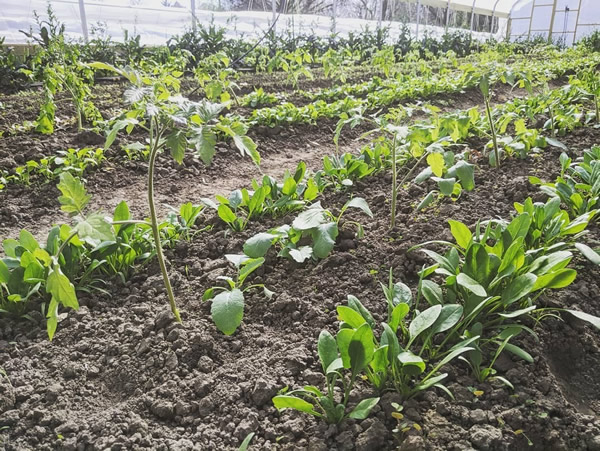
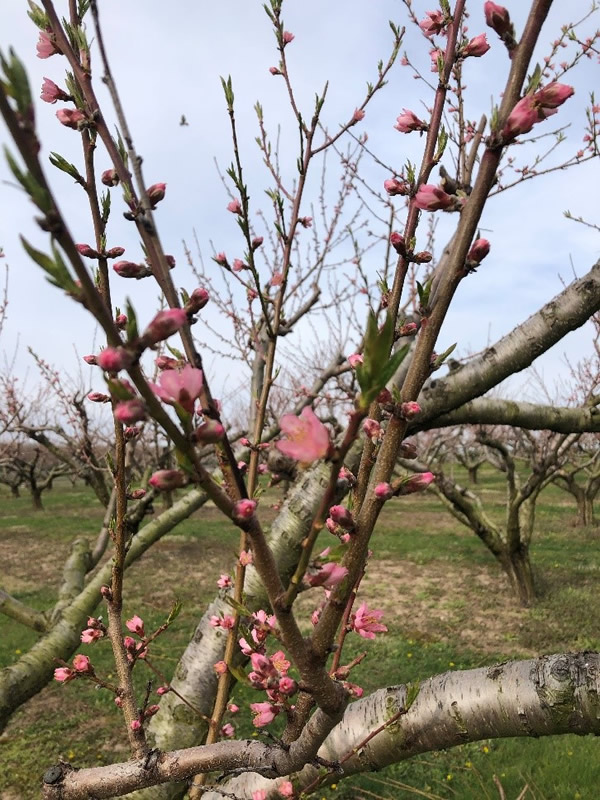
High tunnel intercropping sola: Sola Gratia Farm in Urbana just planted their high tunnel tomatoes between their cool season crops in their high tunnels. 4-8-20 (Left) and Peach blooms: Urbana, IL 4-14-20 (Right)
Erin Harper (217-300-2876; harper7@illinois.edu)
From central Illinois (Decatur)… Past week was mostly a dry week, but the temperatures have varied a lot. Early morning temperatures on April 6 dipped at or below freezing in parts of central Illinois and caused some cold damage.
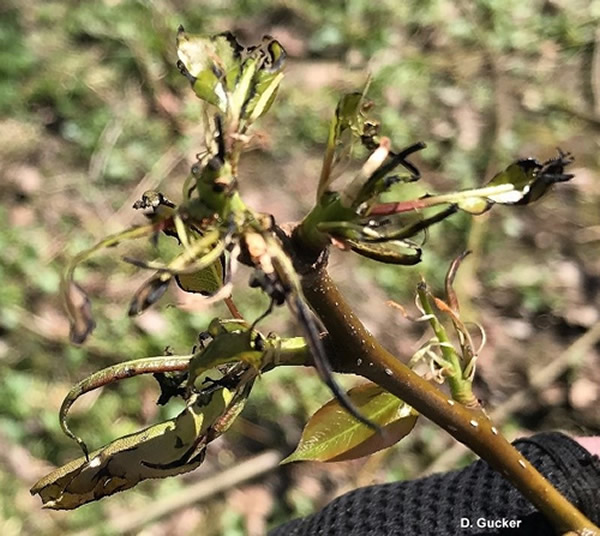
The planting of cool season crops is progressing well in fields with onions, potatoes, peas, greens, and more going into the ground. Reports of early season sweet corn being planted as well.
If your farm does not have an online store, this might be the year to consider it. With social distancing and farmers markets discouraging customer handling of produce, an online store could help with pre-ordering and easy customer pickup of your products.
This is a picture of damage to a lower branch of a pear tree at the “full white” stage. Photo by D. Gucker.
Doug Gucker (217-877-6042; dgucker@illinois.edu)
From west central Illinois (Macomb)… Spring has been, well…spring! Only a few days ago we were sweating it out with highs in the 80s. Only two days later, we were back below freezing. Our ground has dried considerably from the fall moisture, allowing fieldwork to get underway. Already in Macomb, farmers have sweet corn and beans emerging. High tunnels are planted with tomatoes, which saw explosive growth during our spring heatwave. Nature decided to remind what month it is by giving us a week-long stretch of cooler weather and nightly low temperatures in the mid to upper twenties. Those same tomatoes are now covered with row cover and have propane heaters (if they’re lucky) keeping the tunnels warm.
More people may be getting into the growing game, whether it is professionally or personally. One thing we need to clarify for those looking at building a high tunnel is that they don’t necessarily keep the plants “warmer”. If you look at temperature records comparing the temperature inside a high tunnel to the outdoors, by the time we get close to early sunrise, the temperature in a high tunnel is fairly close, if not identical, to the temperature outside. Therefore, relying solely on a single sheet of plastic to keep the plants from freezing, may not yield success. There are strategies to hold the heat longer into the early morning hours, keeping things above freezing before the sun can rise and begin to warm up the tunnel. The primary strategy is a second layer of plastic or row cover over the actual growing beds. Think – low tunnel inside a high tunnel. Like a farmer’s version of Inception. This adds an extra layer of insulation to hold the heat banked in the soil closer to the ground a little bit longer. There is a lot to know when growing in a high tunnel. Check out these high tunnel videos on the Illinois Local Foods YouTube channel.
Despite our status of being holed away as we shelter in place, we are taking every opportunity to get outside, if only to sit on the porch and watch the neighbors watching us. It’s great fun!
Chris Enroth (309-837-3939; cenroth@illinois.edu)
From west central Illinois (Quincy)… What a roller coaster of a spring we’ve had so far. Temperature swings of 40 degrees within a day or two and incredible drying out of soils after April 1st. We got our tomatoes planted April 1st in our tunnels, and then we got the row covers out to protect them from the cold. As I write this (April 14) we’ve used the row covers 4 different nights. But the plants are growing well, and a few blossoms can be found. I’ll be leaving the row covers on for a few more days as low temperatures are expected to be 30 degrees with snow.
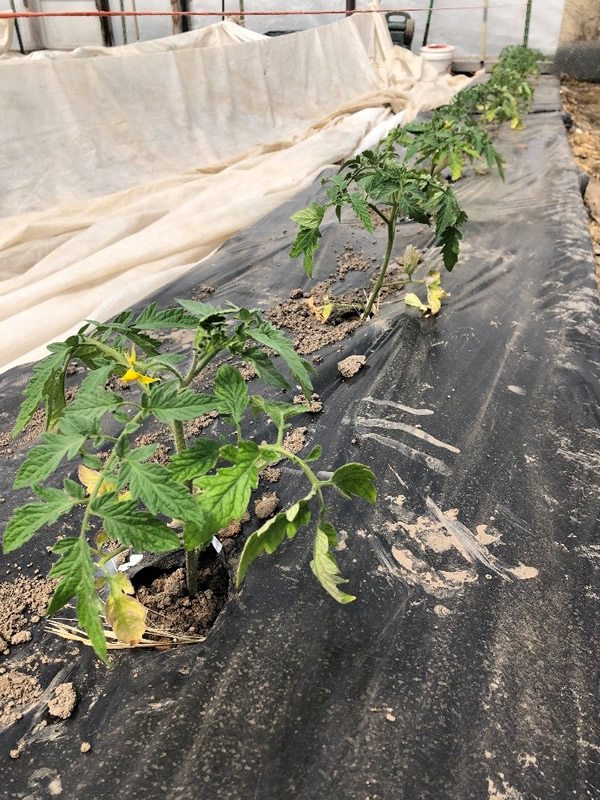
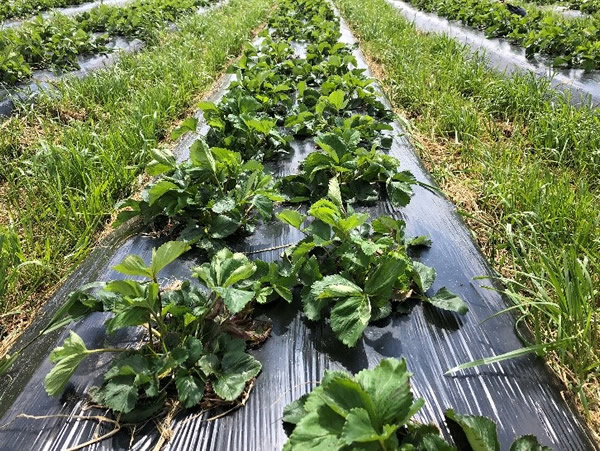
High tunnel tomatoes (top) and plasticulture strawberries (bottom). Photos: M. Roegge
We got our rows of plastic laid for onions and cole crops the first week of March, when we had some dry weather. We got the onions in last week (April 8), and they went in really well. The soil was about perfect under the plastic and we’ve had two showers totaling 2/3” to get them started. We’ll get the cole crops planted next week, after this cold weather passes.
Like most growers of plasticulture strawberries, we sow annual rye between the rows to help with weed control and to make row middles solid enough in case of heavy rains during harvest. Last year they came in real handy with the wet weather. So rather than kill out the rye, I mow it until right before harvest, then make a decision on kill or mow depending upon weather. I’ve done the first mowing, and we’ve got good regrowth. I’ll need to mow again in a week or so to keep it in check. The berries are not showing any buds yet, so not worried about the cold weather. Although McNitt’s suggested we try a couple trays of a new variety (for us) and we got 1/3 of one row of it, they are blooming already. But we’re not protecting it as it’s not enough to worry about.
The asparagus is just now starting to emerge. Although with the high temperature for this week only at 50 degrees or so, we don’t expect to be harvesting for another week or so.
There are a number of corn/soybean farmers who have planted some of their crop. I know of one soybean field planted the first week of March, and last week there were a number of others who got some in. I elected to hold off on sweet corn due to this weeks’ forecast. I don’t like to plant ahead of a cold rain due to the seed stress caused by seedling imbibing cold water. And when I calculated the number of growing degree days from the day I could have planted last week to 10 days out, I arrived at less than 20GGD, which is less than one day in July. So why take the risk.
For the second year in a row, there will be no peaches for us. We had a low of negative 10 this winter, which must have killed the buds. We have a few grapes in the backyard showing bud, and the Honeycrisp tree is also at bud stage. The other apples are only at ½” or so green leaf.
Mike Roegge, Retired Extension Educator & Mill Creek Farms (roeggem@illinois.edu)
From the St. Louis Metro east… Last week temperatures were above average, with a high of 90°F, this week the region is well below average, with highs only reaching into the 50s most days. Though some ground will be lost this week, growers report being about 10 days ahead of last year. Soil temperatures at the SIU Belleville Agricultural Research Station still show a welcome increase with 59.6°F under bare soil at 2”, and 54.1°F under bare ground at 4”. Last week was nice enough for most growers to finish planting tree fruit and Christmas tree nursery stock. One grower put it succinctly, “we were going gangbusters, and then everything came to a screeching halt.” Asparagus was in full harvest last week, including the presence of asparagus beetles on the earliest spears. With the cooler temps, emergence has slowed. Planting of greens, cabbage and collards went in last week and are handling the colder than normal temperatures as expected. Some growers are running burners in high tunnels to protect against overnight chill injury on sensitive crops like tomatoes. Bloom thinning of peaches is ongoing. Apples are in all stages of bloom, from early bloom to almost first cover. Plasticulture strawberries are in bloom and temperatures are dropping enough overnight for much of the week to warrant protection. Growers with covers pulled them back on Monday afternoon and will most likely be pulling covers on and off throughout this unusual cold spell. Covers may be a hassle, but they take much of the guesswork out of protecting a strawberry crop. Strawberry blossoms cannot endure temperatures below 28°F, but growers using sprinkler irrigation for protection shouldn’t wait for temperatures to get that low before taking action. Growers also shouldn’t assume the air temperature and the blossom temperature are going to be the same. When they do diverge, that could result in starting an irrigation system too late or shutting off too soon. On frost nights, especially when the air is particularly dry, the strawberry blossom temperature can sometimes be 2-3°F lower than the air temperature. That’s why it is so important to take measurements as close to the canopy as possible if you are not measuring blossom temperature directly with a thermocouple, and to start your irrigation system as air temperatures hit the 34°F mark. If you are measuring blossom temperature directly with a thermocouple, start your irrigation system when the blossom temperature drops to 31°F. Irrigation can provide excellent protection when wind speed is below 10 mph, but as wind speed picks up and temperatures drop, irrigation rates must significantly increase to offset losses to evaporation (cooling effect). See Barclay Poling’s archived notes on this subject https://www.ces.ncsu.edu/wp-content/uploads/2009/03/StrawberryPlasticulureAdvisoryApril1505.pdf?fwd=no .
Growers are reporting good success with curbside pickup during the stay-at-home order, either organized through a farmers market and/or organized by the farm itself. Customers are making online orders that includes pre-payment, usually through Facebook or a business website. The customer then comes to the arranged site and picks up their order with no significant face-to-face contact since payment is already taken care of. Not only are produce items popular, but a higher than normal demand for vegetable transplants is being reported.
Elizabeth Wahle (618-344-4230; wahle@illinois.edu)
From southwestern Illinois (Waterloo)... It has been quite a roller coaster for temperatures lately. Last week on Wednesday (4/8) much of the area hit 90° however this Wednesday (4/15) the morning low was 32° at Waterloo. So far I have not seen any frost any mornings or any damage from the cold on our fruit crops hopefully if we can get through this week we will be out of the woods for the cold at least for now. Our area continues to be mostly dry. There were a few showers that passed through on Friday (4/10) and some on Saturday into Sunday, but they didn’t amount to enough to slow any field work very long. Some planted crops would actually appreciate some rainfall which is predicted for the end of the week.
I planted potatoes on 4/2 and the soil was a little damp, but tilled well and dried fairly quickly. I was worried about beating “big rain”, but to date that rain still hasn’t come. At that time pears were in full bloom. We also planted our first sweet corn planting. I have seen more growers no-tilling some early sweet corn. A good “no-till seedbed” can actually plant better (better soil tilth and row closure) and earlier than the point where you can get the whole field to work up. I have also observed less crusting, allowing for easier emergence, especially if it is a field that has some history of no-till.
Fast forward to today and peaches are done blooming, most apples are in full bloom or getting close to it, tart cherries and early blueberries like ‘Duke’ are in full bloom. Asparagus has been in harvest for about a week now and it has good quality with the cooler temperatures. Asparagus beetles have also been out already so be scouting. They were not up to an economic threshold yet and the cold weather slowed them down. I have an article later in this issue talking more about asparagus beetle management.
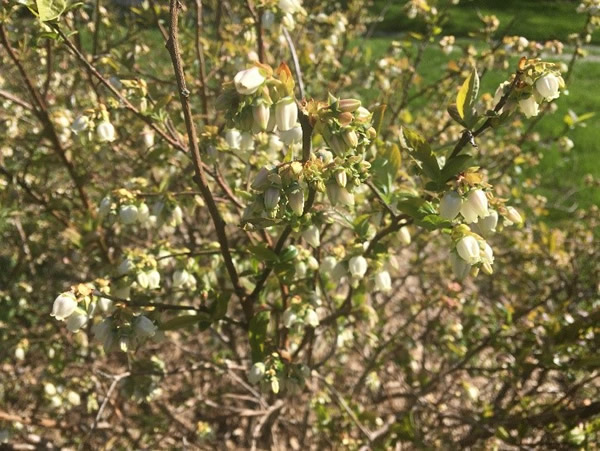
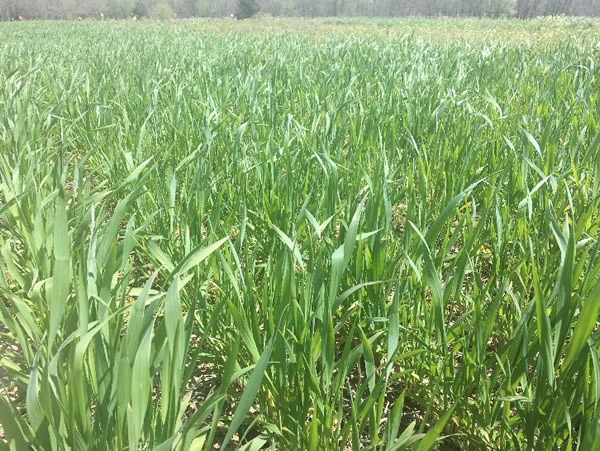
‘Duke’ blueberries in bloom (left) and current cereal rye growth (right). Photos: N. Johanning
Cover crops are really starting to take off. Cereal rye is rapidly starting to accumulate biomass most is between 12”-18” tall. Likewise clovers and overwintering covers are growing quickly. The weather this year has been more favorable this year to manage cover crops as needed and lets hope that pattern continues.
Nathan Johanning (618-939-3434; njohann@illinois.edu)
From southern Illinois (Murphysboro)… This month the Jackson County Ag and Natural Resources team launched our Beginning Gardener webinar series. So far, we have covered Site Selection and Preparation, Soil, and Plant Selection. Our upcoming topics will be Plant Nutrition, Succession and Companion Planting, and Harvesting and Storage. The recorded webinars will be located on the new Unit 26 Youtube channel https://www.youtube.com/channel/UCQNQbCcpijZHTdbSXVC73Nw
The zinnias, snapdragons, cucumbers, cantaloupe, and squash seedlings in the high tunnel are continuing to grow and most have been repotted into 4-inch pots. They will be ready to be transplanted in the outside raised beds soon as well as in the tunnel.
We harvested asparagus for the first time April 8th and have made a total of three harvests thus far. This is the 6th year of the trial which features 12 varieties of asparagus.
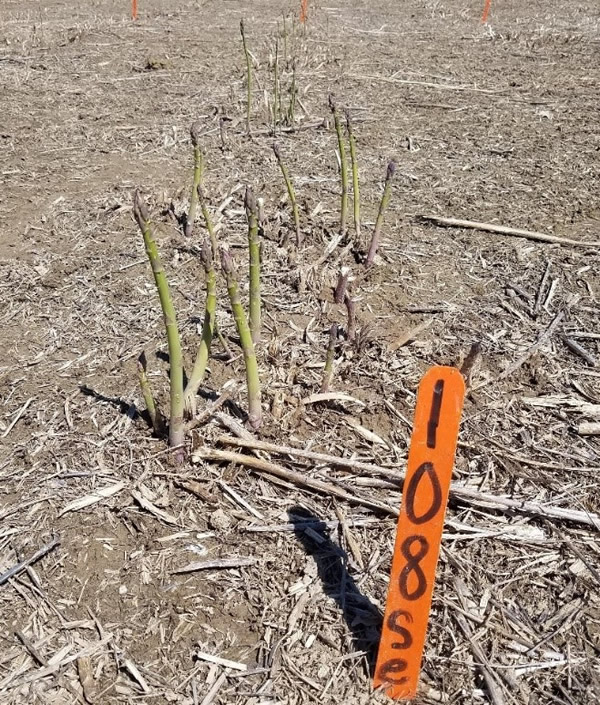
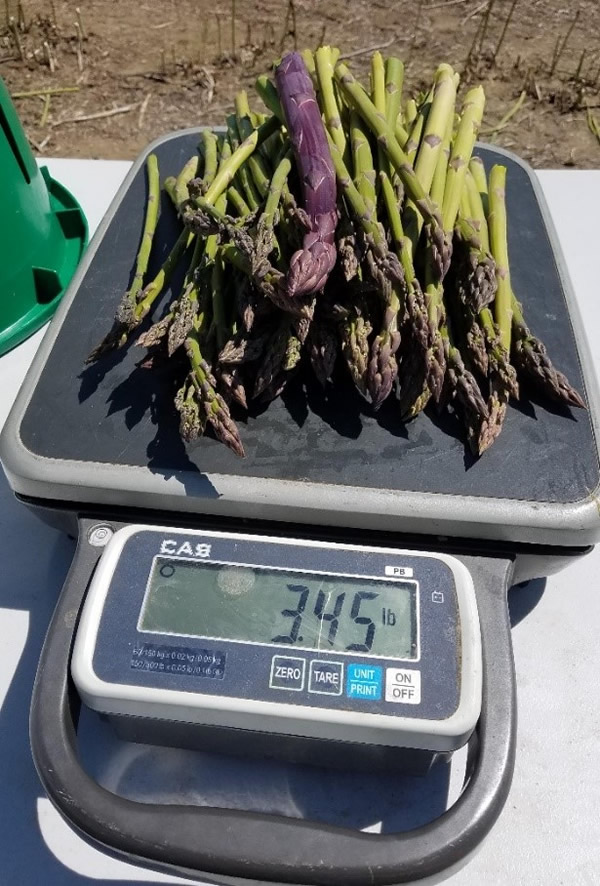
Asparagus plot at the Jackson County Extension office in its 6th year of production (left); yield data being collected during the third harvest of the 2020 season (right). Photos by K. Bell.
On April 10th four rows of black plastic were laid in preparation for upcoming trials including a showcasing of heirloom tomato varieties and a red slicing tomato fertigation trial. The heirloom showcase will feature 10 different varieties that may be grown by home gardeners.
Thanks to Marc Lamczyk and Nathan Johanning for their help with preparing the ground and laying plastic!
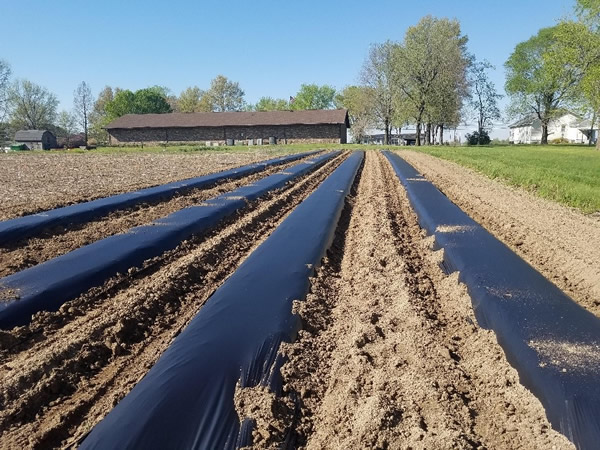
Black plastic mulch laid on April 10, 2020 at the Jackson County Extension office. Photo by K. Bell.
Katie Bell (618-687-1727; klbell@illinois.edu)
From Dixon Springs Ag Center…During the first week of April, tomatoes and strawberries were planted in two of the high tunnels at DSAC. ‘Monterey’ crowns, an ever bearing variety, were received earlier in the year and started in 2” pots in the greenhouse. These were then transplanted into the vertical stack system in the hydroponic tunnel. For this season, three different substrate, or growing media, blends were used in the stack system and include 100% perlite, 100% coco coir, and 50/50 perlite/coco coir blend. Yield data will be collected from each stack throughout the growing season to evaluate response to the different substrates.

‘Monterey’ strawberry planted into different substrate blends in hydroponic vertical stacks in high tunnel at DSAC. Photo by B. Aly.

Row cover was used as a precaution to protect tomato plants in the hydroponic tunnel at DSAC several nights in the middle of April as temperatures dipped into the low 30s and frost advisories were issued. Photo by B. Aly.
With the frost advisories being issued this past week, row cover was laid out and used to cover the tomato plants that had been set out in both the hydroponic and in ground raised-bed tunnel. Several different cherry/grape type indeterminate tomato cultivars along with a few slicing/beefsteak type were set out in the hydroponic tunnel. As in the past, dutch buckets will hold one or two plants (depending on the variety) and these plants will be trained up a single trellis string supported from the trussing inside the tunnel. An irrigation controller is set up to deliver water and fertilizer throughout the day and point source emitter stakes are placed at the base of each plant.
Cucumbers and peppers will be planted in the remaining buckets within the hydroponic tunnel, and the lettuce table should be up and running by the end of next week.
The tomatoes planted in the in ground raised bed tunnel (pictured below) will be part of a replicated determinate tomato variety trial for the 2020 season. Plants were spaced at 24” and will be staked and trained using the trellis weave or Florida weave system. Each bed has two drip irrigation lines with 4” emitter spacing. All of the beds in the tunnel, including the beds planted to peppers, received a pre-plant fertilizer application of 12-12-12 at a rate of 50lbs/acre. Row covers were used in this tunnel as well this past week to protect these tender plants from potential cold injury.
A bell pepper spacing study was planted on April 10th to evaluate yield response in relation to spacing within a high tunnel production system. For this project, one variety of bell pepper was used in all the plots, and plants were spaced at either 12”, 18’, or 24” in both single and double rows. Two lines of drip irrigation (4” emitter spacing) are run in each bed, and all plots will receive the same amount of fertilizer (pictured below).
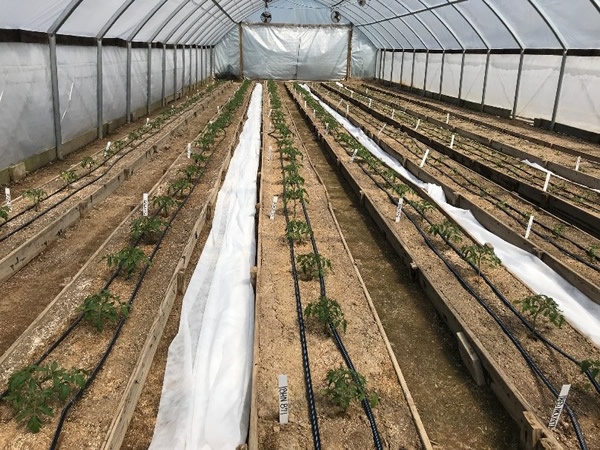
Tomato variety trial in in ground raised bed high tunnel at DSAC. Thirteen different cultivars will be evaluated. Photo by B. Aly.
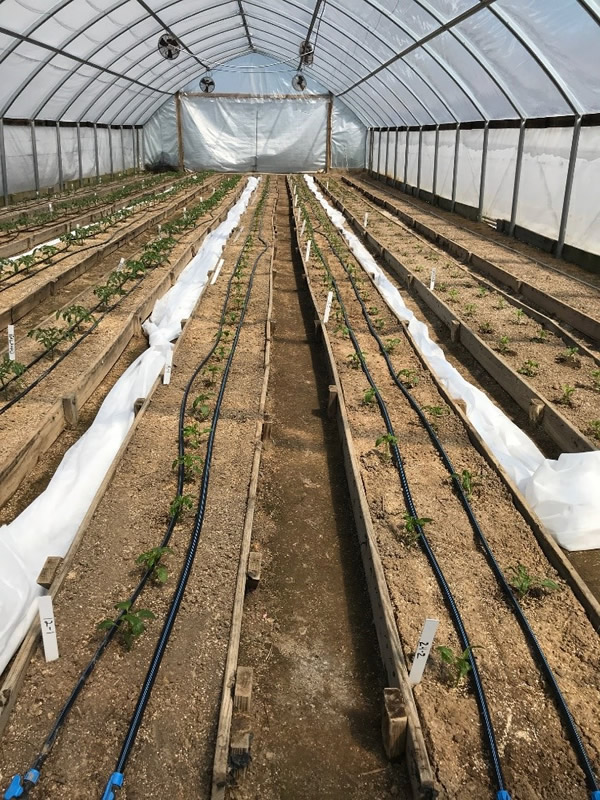
Bell pepper spacing study at DSAC in in ground raised bed high tunnel production system. Photo by B. Aly.
In regards to the winter vegetable production project, all of the plots have been terminated except for the December, January, and February planted carrots. December planted carrots will be harvested this week. The empty beds in that tunnel will be cleaned out, tilled, steamed, and planted to onions radishes and beets, keeping production uniform in each bed so as not to confound plots that will be established for the 2020/2021 fall/winter production season.
For those who may be interested in seeing a weekly video with updates and the progression on projects being conducted in the high tunnels at DSAC, visit our Facebook page, U of I Ext Local Foods/Small Farms - Southern Illinois
https://www.facebook.com/localfoodssmallfarmsUofIExtensionsouthernIL/?ref=aymt_homepage_panel&eid=ARCH7s4QK3oQVwpor4krn40id5XY8eAwy-EDx-SLz4pK-UU4Omf9bqs2qBqfNg5_LntdU6_cX0sRhIis
There are currently two videos posted on the page, one from April 3 and one from April 10. The plan is to record a new video each Friday and post to the page, which sometimes may not be until Saturday. If you have questions on something you see, please feel free to send me an email or pop the question into the comments under the video.
Bronwyn Aly (618-382-2662; baly@illinois.edu)
Fruit & Vegetable Production & Pest Management
Modified Growing Degree Days for Insect Development (Base 50⁰ F, January 1 - April 14)
Station Location |
Actual Total |
Historical Average (11 year) |
One- Week Projection |
Two-Week Projection |
Freeport |
59 |
79 |
90 |
127 |
St. Charles |
80 |
83 |
110 |
144 |
DeKalb |
69 |
94 |
103 |
143 |
Stelle |
103 |
119 |
143 |
187 |
Peoria |
130 |
140 |
174 |
223 |
Monmouth |
114 |
123 |
154 |
198 |
Champaign |
147 |
143 |
192 |
240 |
Springfield |
166 |
165 |
216 |
271 |
Perry |
167 |
176 |
216 |
266 |
Brownstown |
204 |
212 |
261 |
321 |
Olney |
229 |
204 |
284 |
342 |
Belleville |
271 |
237 |
331 |
393 |
Rend Lake |
265 |
258 |
331 |
399 |
Carbondale |
304 |
258 |
367 |
431 |
Dixon Springs |
312 |
291 |
380 |
450 |
Insect development is temperature dependent. We can use degree days to help predict insect emergence and activity. Degree day accumulations calculated using the Pest Degree-Day Calculator
Kelly Estes, State Survey Coordinator, Illinois Cooperative Agricultural Pest Survey (217-333-1005; kcook8@illinois.edu)
Asparagus Beetle Management
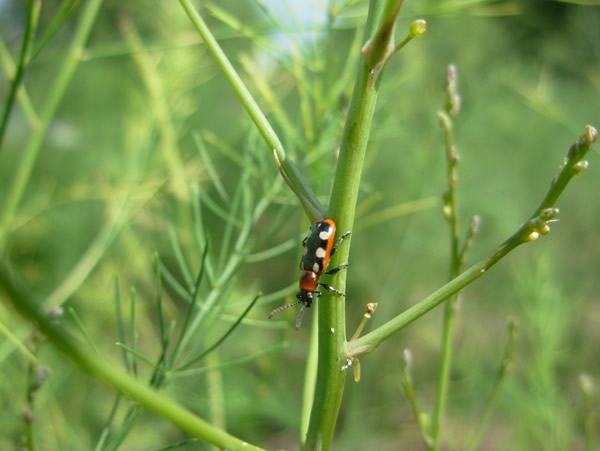
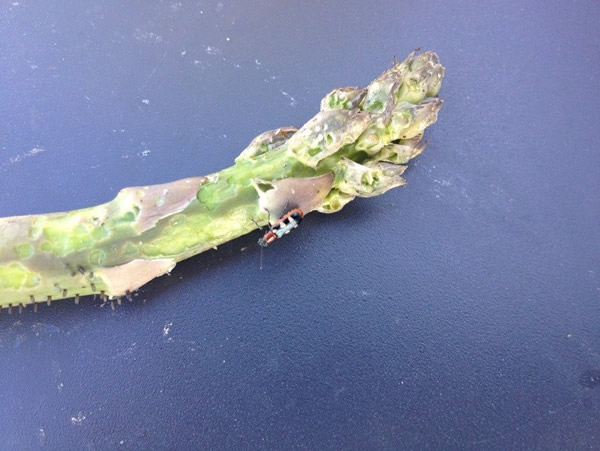
Photos: N. Johanning
Asparagus beetles can be very devastating to asparagus fields this time of year. The asparagus beetle overwinters as adults and they emerge in the spring and immediately start feeding. They start laying eggs one week after emergence. The eggs are laid in rows of 3 to 8 eggs on spears. Larva hatch and also feed on spears and ferns before maturing and burrowing into the ground to pupate after around two weeks.
For commercial production the feeding on the spears can cause huge loses in marketable yield. As you can see for the pictures to the right, the eggs (small grayish black, sticking straight out of the fern) and also round surface feeding can quickly render spears unusable.
The economic threshold for insecticide treatment for asparagus beetles during harvest is 2-10% of plants infested or 2% of spears with eggs. Scouting is best done in the afternoon when the beetles are the most active. The thresholds for fields with a history of outbreaks might be even lower.
The following products are labeled for use in asparagus during harvest for asparagus beetle control, all of which have a 1-day PHI.
- Assail 30SG
- Lannate LV
- Lorsban 4E
-
Photos: N. Johanning
Sevin XLR Plus 4FFor organic growers, Entrust can be used after harvest is done for the season to reduce populations; however, it has a 60 day PHI so it cannot be used during harvest.
Cultural practices such as removing/destroying old ferns and places for beetles to overwinter can be helpful. Also, when harvesting, harvest the field clean as with that you will remove eggs rather than leaving small or cull spears in the field to be a host for eggs. For more details on the products listed above and other management practices refer to the Midwest Vegetable Production Guide .
Nathan Johanning (618-939-3434; njohann@illinois.edu)
Less Seriously
As I was helping my son with one of his remote learning lessons, there was a section discussing old sayings or adages, which lead to some good conversation on the meaning of some of these sayings and wondering what circumstances may have inspired certain phrases. And then it occurred to me, and he agreed, we are in one of those times that might lend to the creation of another round of really insightful, thought provoking adages.
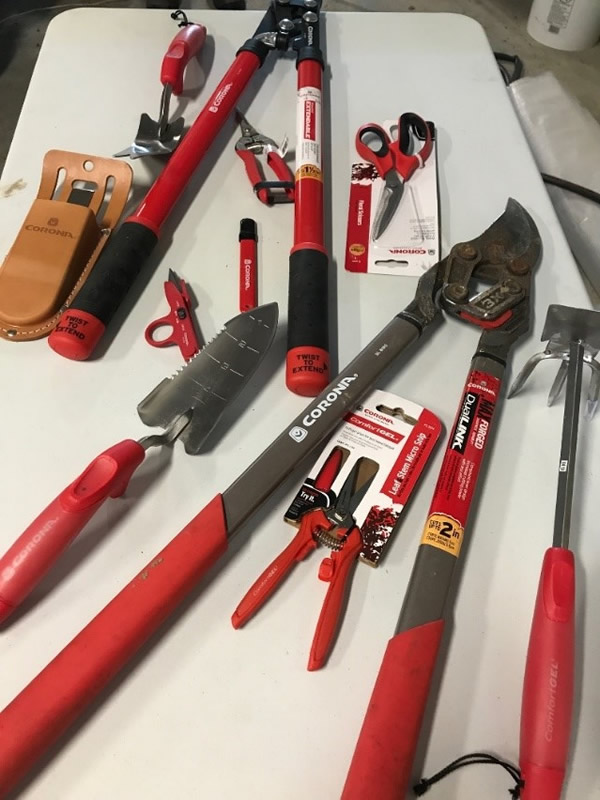
What do you think, will this stand the test of time?
University of Illinois Extension Specialists in Fruit and Vegetable Production & Pest Management
Extension Educators – Local Food Systems and Small Farms
Bronwyn Aly, Gallatin, Hamilton, Hardin, Pope, Saline, and White counties
618-382-2662
Katie Bell, Franklin, Jackson, Perry, Randolph, & Williamson counties
618-687-1727
Sarah Farley, Lake & McHenry counties
847-223-8627
Nick Frillman, Woodford, Livingston, & McLean counties
309-663-8306
Laurie George, Bond, Clinton, Jefferson, Marion, & Washington counties
618-548-1446
Zachary Grant, Cook County
708-679-6889
Doug Gucker, DeWitt, Macon, and Piatt counties
217-877-6042
Erin Harper, Champaign, Ford, Iroquois, and Vermillion counties
217-333-7672
Grace Margherio, Jackie Joyner-Kersee Center, St. Clair County
217-244-3547
Grant McCarty, Jo Daviess, Stephenson, and Winnebago counties
815-235-4125
Katie Parker, Adams, Brown, Hancock, Pike and Schuyler counties
217-223-8380
Kathryn Pereira, Cook County
773-233-2900
James Theuri, Grundy, Kankakee, and Will counties
815-933-8337
Extension Educators – Horticulture
Chris Enroth, Henderson, Knox, McDonough, and Warren counties
309-837-3939
Richard Hentschel, DuPage, Kane, and Kendall counties
630-584-6166
Andrew Holsinger, Christian, Jersey, Macoupin, & Montgomery counties
217-532-3941
Extension Educators - Commercial Agriculture
Elizabeth Wahle, Fruit & Vegetable Production
618-344-4230
Nathan Johanning, Madison, Monroe & St. Clair counties
618-939-3434
Campus-based Extension Specialists
Kacie Athey, Entomology
217-244-9916
Mohammad Babadoost, Plant Pathology
217-333-1523